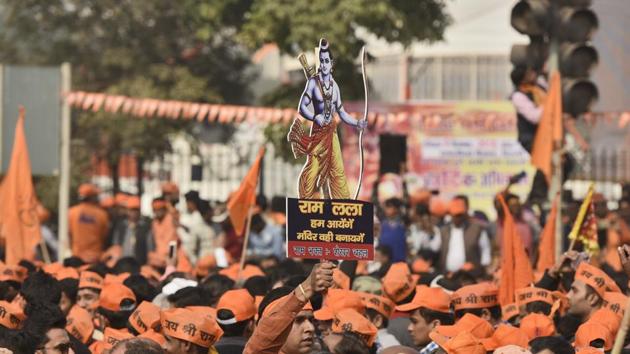The rise of the proud, global Hindu
The Ayodhya movement redefined secularism, brought the political Hindu to the centre stage
The pandemic is certain to ensure that the bhoomi pujan of the proposed Ram Janmabhoomi temple in Ayodhya on August 5 will be an extremely sanitised affair, despite the extraordinary significance of Prime Minister (PM) Narendra Modi’s presence. No doubt the occasion will be solemn and will be marked by the presence of a few hundred guests, carefully chosen for their contributions to a movement that has dramatically altered the politics of India and the mentality of a majority of Hindus.

Yet, it will be a very different occasion from the shilanyas on November 9, 1989, when Kameshwar Chaupal, a Dalit, was specially chosen to lay the first consecrated brick for the temple at a spot that the Congress government of the day had, after much agonising and calculation, deemed to be undisputed. The day had a special significance: It coincided with the fall of the Berlin Wall, an event that culminated in the collapse of the erstwhile Soviet Union. It also marked the first occasion in independent India that there was a mass mobilisation of kar sevaks in Ayodhya for the construction of a Ram temple and, by implication, the removal of the 16th century Mughal shrine that had, however, been functioning as a Ram temple since 1949.
What the jurist Nani Palkhivala described as the Ayodhya years were heady times marked by high emotionalism and political polarisation. Beginning with the consecration of nearly 200,000 bricks from all over the country and culminating in the 1996 general election that saw the Bharatiya Janata Party (BJP) displace the Congress as the largest party in the Lok Sabha, India was in ferment. On the face of it, the mass mobilisation of Ram bhakts was aimed at the construction of a temple on the spot where lord Ram was believed to have been born — a quasi-religious movement that also incorporated the demand to right a historical wrong. However, the significance of the Ayodhya movement was more far-reaching.
First, the movement reopened a debate that had been left deliberately inconclusive by the founding fathers of the Republic: The meaning of secularism in the Indian context. The premise that the Indian State would maintain a measure of equidistance from all faiths and show equal respect to all beliefs was understood. The Constitution also guaranteed statutory protection to minority religions. At the same time, despite the attempts by modernists to rise above all forms of symbolism, it was generally accepted that the cultural underpinnings of Indian nationhood were, loosely-speaking, Hindu — but not exclusively so.
This loose consensus based on good sense and mutual accommodation was broken in 1976 when, at the height of the Emergency, Indira Gandhi injected the term secularism into the Constitution. Hitherto, secularism had been understood in spirit but never written into the rule book of public life. The immediate consequence of this shift to “progressive” politics were attempts at a codification of Jawaharlal Nehru’s belief — as elucidated by his official biographer S Gopal — that “the problem of minorities was basically one for the majority community to handle. The test of success was not what Hindus thought but how Muslims and other communities felt…” Translated into secularist politics, this implied that Hindus must live in a state of permanent magnanimity, and, in the realm of competitive politics, never assert themselves as Hindus. The Ayodhya movement challenged this pseudo-secularism — LK Advani’s coinage that acquired popularity in the 1990s — frontally.
Second, in attempting to re-establish the Hindu underpinnings of Indian nationhood, the Ayodhya movement brought the political Hindu to the centre stage of public life. There was undeniably an element of faith in the movement for a Ram temple, but its mass appeal owed almost entirely to a political context. There was the outbreak of separatism in the Kashmir and the expulsion of Hindu Kashmiris from the Valley, a momentous development that the secular parties chose to brush under the carpet. Then there was the Rajiv Gandhi government’s infamous U-turn on the Supreme Court’s Shah Bano judgment that sought to effect minor reforms in Muslim personal laws. These, plus the prevarication over the Ram temple and a tacit endorsement of the demolition of the Babri shrine on December 6, 1992, contributed significantly to the belief that Hindus must have a distinctive voice in politics to overcome the sectional veto. This manifested itself loosely in the elections of 1996, 1998 and 1999 and then more powerfully in 2014 and 2019.
Hindutva, as defined by Veer Savarkar in the 1920s and 1930s, was too ideological for popular tastes and its appeal was limited, especially when pitted against Mahatma Gandhi’s leadership of the national movement that resonated with Hindu symbolism. The new Hindutva that evolved after the post-liberalisation rise in living standards blended cultural pride with a sense of national assertiveness.
The Ayodhya movement was an important input in forging this new mentality and Narendra Modi became its icon. But whereas the first phase of the Ayodhya movement was defined by mass mobilisation, civil unrest and an outpouring of passion, its post-1996 articulation was marked by a quiet confidence that comes with the awareness that the main battle has been won. Ayodhya helped shape the transformation of the meek Hindu and the submissive Hindu into a proud Hindu and even a global Hindu, along the lines Swami Vivekananda had hoped for.
The monument to lord Ram, built on the site of an ancient temple, could yet become a powerful symbol of resurgent nationhood.






